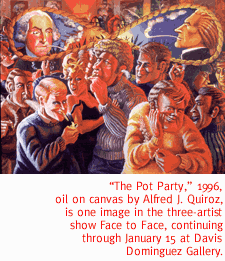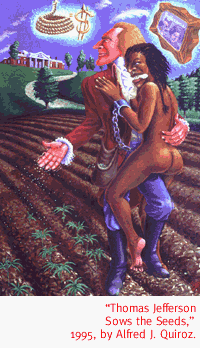

|

Alfred Quiroz Takes On The High And Mighty At Davis Dominguez Gallery.
By Margaret Regan
ACCUSTOMED AS WE'VE become to all Monica all the time,
it's a shock to find no Monica, none of the time, in Alfred Quiroz's
suite of paintings of presidential scandals.
To be sure, there's a Bill Clinton painting in Quiroz's presidential
rogues gallery, part of a three-person exhibition called Face
to Face at Davis Dominguez Gallery. But "The Pot Party"
is from an old Clinton file. Bathed in the weird orange half-light
of marijuana bacchanals of days gone by, this neon-hued oil on
canvas features a swinging '70s Bill. Sporting a head of blond
curls (Note to the Quiroz research department: Is this hair historically
accurate?), Bill is indeed inhaling, so much so that he's snorting
small clouds of smoke right out his ears. He's cavorting with
a décolleté blonde, but it's hard to tell whether
she's Gennifer Flowers. The face of yesterday's girl has been
so obliterated by the ripe features of Clinton's more recent
paramour that we can scarcely remember her.
 Quiroz, a UA painting prof, is renowned for his fiery indictments
of evils throughout the history of the New World. With all the
fury of an Old Testament prophet, he turns his wrath on debacles
from the Spanish conquest of the Americas to the U.S. fiasco in
Vietnam. Working in an inimitable faux-cartoon style, he ratchets
his colors up to lurid and pushes his caricatures to extreme.
His work is not always easy to like, but one has to respect his
commitment to deflating cherished history-book myths, an uncommercial
project if there ever was one.
Quiroz, a UA painting prof, is renowned for his fiery indictments
of evils throughout the history of the New World. With all the
fury of an Old Testament prophet, he turns his wrath on debacles
from the Spanish conquest of the Americas to the U.S. fiasco in
Vietnam. Working in an inimitable faux-cartoon style, he ratchets
his colors up to lurid and pushes his caricatures to extreme.
His work is not always easy to like, but one has to respect his
commitment to deflating cherished history-book myths, an uncommercial
project if there ever was one.
This painter's work is so fierce, and so pointed, that it's disappointing
not to have an astringent Quirozian explication of Zippergate.
He does nevertheless offer up piquant analyses of misdeeds by
three other presidential icons: to wit, Ronald Reagan ("Da
Grate Kommie-Nuke-Ater," Quiroz calls him), John F. Kennedy
and Thomas Jefferson, recently in the news.
"Thomas Jefferson Sows the Seeds" takes our third president
to task for his liaison with the enslaved Sally Hemmings, the
half-sister of his late wife. The pair, whose descendants recently
provided incontrovertible DNA proof of their coupling, stand in
the lush fields of Virginia, architect Jefferson's glorious home,
Monticello, looming on the horizon. They're a kind of Adam and
Eve of multicultural America, this stiff white gentleman and curvy
black woman, and Quiroz pushes the metaphor by having Jefferson
scatter some seeds in the furrowed earth.
As a matter of fact, their union might make a fine emblem for
the birth of the diverse American nation--except for the distressing
knowledge that we bring to it. This is the man, after all, who
wrote in the Declaration of Independence that "all men are
created equal" and owned a plantation's worth of his fellow
human beings. And for all our DNA evidence, we'll never know what
Hemmings thought of Jefferson, as a de facto husband and the father
of her children, or as a legalized rapist.
 "Ask Not" deals with sex too, but it's less morally
complicated than the Jeffersonian kind. JFK nowadays seems more
like an old-fashioned, slightly embarrassing playboy on the order
of Hugh Hefner. In the Quiroz painting, an oil on oak panel, visions
of sex literally dance in JFK's gigantic head. Marilyn Monroe's
arm doubles as his nose, somebody else's bare bottom is his chin,
a dusky beauty blends into his wavy hair. Somehow, though, Quiroz
can't summon up much venom for the philandering saint of latter-day
idealism. Indeed, an image of Jackie's blood-stained pink suit
hovers above the scene like a transmogrified Virgin of Guadalupe.
"Ask Not" deals with sex too, but it's less morally
complicated than the Jeffersonian kind. JFK nowadays seems more
like an old-fashioned, slightly embarrassing playboy on the order
of Hugh Hefner. In the Quiroz painting, an oil on oak panel, visions
of sex literally dance in JFK's gigantic head. Marilyn Monroe's
arm doubles as his nose, somebody else's bare bottom is his chin,
a dusky beauty blends into his wavy hair. Somehow, though, Quiroz
can't summon up much venom for the philandering saint of latter-day
idealism. Indeed, an image of Jackie's blood-stained pink suit
hovers above the scene like a transmogrified Virgin of Guadalupe.
When we arrive at the Reagan painting, we realize what Quiroz
was saving his wrath for. An oil on mahogany carved into a circle
some 12 feet in diameter, the painting puts Reagan's head at the
bull's eye of a giant target. The Great Communicator may be old
now, impossibly wrinkled, his eyes closed, but he's still responsible
for his sins.
In the first circle around his face he's still an innocent, a
movie actor in black and white, playing a soldier, a bon vivant,
a cowboy. But in the outer circle, more evil, like Dante's deeper
circles of hell, Reagan metamorphoses into a corrupt president.
Stacks of dollar bills trail his every move, and in his wake
are impoverished homeless, blown-up soldiers, savings-and-loan
swindlers. A Middle Eastern potentate shoves guns up the bowels
of an American solider, presumably a reference to the illegal
arms for hostages deal. Creepy Central American killers smile
at their handiwork, the murders of Indians and peasants whose
deaths were subsidized by the Reagan administration. With crimes
as horrific as these--all unimpeachable, apparently--JFK's amours
and Clinton's tokes, and even Clinton's analysis of "is,"
pale into venial sins.
ANDREW POLK, HEAD of the UA art department, has created some giant
heads of his own, Bosch-like grotesques that match Quiroz's in
intensity.
 "Digital drawings," printed out large in black and
white, are nightmarish heads filled with horrors multiplied infinitely
by the computer. Hordes of little wooden heads burst out of the
larger skull in "Pierced Skin Trophy." "Aging Avarice
Inner Theatre" is another ugly head in profile; inside this
one, dozens of wooden artist's maquettes lie atop each other.
With their arms and legs deployed in all directions, they look
like victims of a brutish massacre.
"Digital drawings," printed out large in black and
white, are nightmarish heads filled with horrors multiplied infinitely
by the computer. Hordes of little wooden heads burst out of the
larger skull in "Pierced Skin Trophy." "Aging Avarice
Inner Theatre" is another ugly head in profile; inside this
one, dozens of wooden artist's maquettes lie atop each other.
With their arms and legs deployed in all directions, they look
like victims of a brutish massacre.
It's a bit of a relief to come to the more gentle work of Robert
Royhl, a UA-trained artist who paints in oil and egg tempera and
Japanese mineral pigments. Now a professor in Montana, Royhl works
in a vaguely Asian style, building up layers of transparencies
and rendering faces with liquid delicacy. He draws likenesses
from life but his colors are his own. The lovely "Saiyin"
is a portrait of a woman in pale purple, amber, blue and greens.
There are two sensitive portraits of the artist's father. The
old man is in profile in an egg tempera work, colored in the same
tints as "Saiyin," with bold lines atop the washes.
In a colored pencil drawing, he's simpler, more stripped down,
more ready to leave this life. With a few deft lines, the son
has captured the open-mouthed, bony face of a man who will soon
see death.
Face to Face, an exhibition of work by Alfred Quiroz,
Andrew Polk and Robert Royhl, continues through Friday, January
15, at Davis Dominguez Gallery, 154 E. Sixth St. Gallery hours
are 10 a.m. to 5 p.m. Tuesday through Friday, and 10 a.m. to 4
p.m. Saturday. For more information call 629-9759.

|
 |





